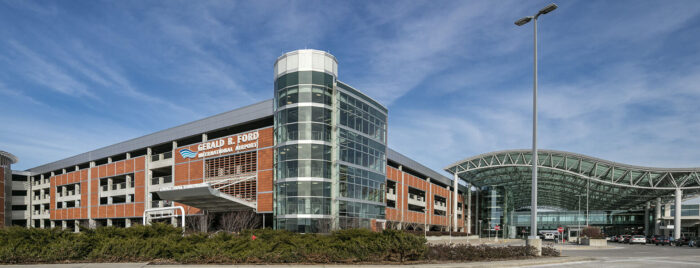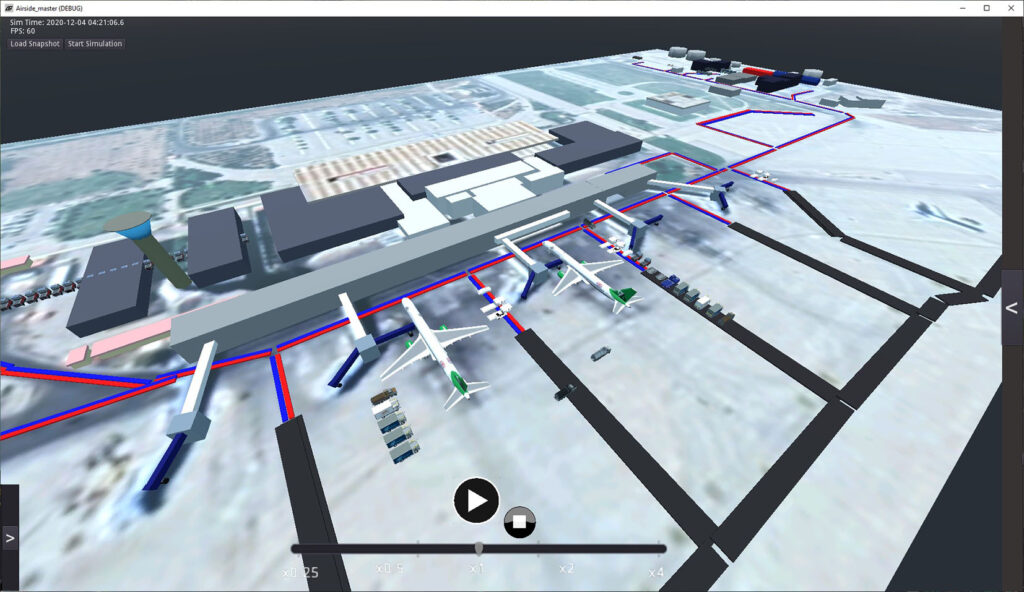UK-based autonomous technology developer Aurrigo is embarking on an aviation first in the USA by using its Auto-Sim software platform to create a digital twin of airside operations at Gerald R Ford International Airport in Michigan.
Supported by the Ford Launchpad for Innovative Technologies and Entrepreneurship (FLITE) initiative, which provides pilot-testing opportunities to companies focused on bringing emerging air travel solutions to market, Aurrigo will identify cost savings, enhance customer experience, achieve a host of environmental improvements and lay the foundations for how the airport could implement autonomous operations in the future.
Utilizing a PlanetM Testing Grant from the Michigan Economic Development Corporation, Aurrigo will build a model of airside operations, covering roadways, intersections, stands and all operational vehicle types and movements. A team of simulation engineers and project management specialists based in the company’s engineering center in Coventry, UK, will work with Ford International Airport planning staff to integrate vehicle fleet capacity and flight schedules so they can simulate airside servicing to benchmark current operations and predict future scenarios.
In addition to modeling operations, the Auto-Sim software platform can simulate the effects of staff shortages due to Covid-19, flights delays, the de-icing schedule for departing aircraft and severe weather events including heavy snow and ice.
David Keene, CEO of Aurrigo, said, “The world’s airports are all facing the same challenge of providing greater levels of customer service with the most cost-effective use of resources and minimal environmental impact. It’s a careful balancing act and one brought into even sharper focus with the impact of the Covid-19 pandemic.
“Auto-Sim will enable Ford International Airport to be the first in the US to complete a real-world feasibility study of a current airport using digital twin technology. This allows airport planners to model the operational processes, financial implications, customer journey experience and environmental impact of implementing new technology without the risk of expensive mistakes.
“We hope it will encourage other airports within the US and around the world to utilize the Auto-Sim platform to streamline operations and reduce their environmental impact, while also providing the optimal customer experience and preparing them for future operations that involve airside automated vehicles.”

Aurrigo will work with Ford International Airport and consortium partners Southwest Airlines, Stantec, Seamless and the Michigan Office of Future Mobility & Electrification to complete this project by the end of May 2022.
Auto-Sim can replicate the airport’s busiest periods, which on any given day could include 112 aircraft movements, requiring upward of 1,000 individual activities to be serviced.
Before the pandemic, Michigan’s second busiest airport catered for nearly 3.6 million annual passengers and, in 2019, handled 41.4 million kilograms of air freight – all considerations that will be factored into the modeling work.
The technology can also generate detailed energy consumption data for every vehicle modeled in the airside operations, including optimizing current operations and exploring ways to minimize distance traveled to service the flight schedule.
Tory Richardson, president and CEO of Gerald R Ford International Airport Authority, said, “FLITE enables us to partner with entrepreneurs and established companies focused on developing innovative new products and services to improve airport operations and the air travel experience for guests. We are proud to welcome Aurrigo to our airport to offer them the opportunity to test their Auto-Sim software platform alongside our airside operations.”
Aurrigo previously used its Auto-Sim technology to help Changi Airport in Singapore with development work on a new terminal. The company was founded by brothers David and Graham Keene nearly 30 years ago and has also used its in-house software, technology and engineering expertise to develop the Auto-Dolly, a new autonomous luggage and cargo system that has the potential to deliver 60% carbon savings for airports.
It is anticipated that the digital twin modeling work could prove the business case for these dollies to replace two-thirds of conventional diesel-powered luggage and cargo tractors and trailers.

